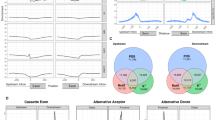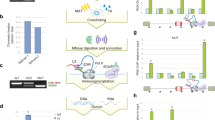Abstract
The exon junction complex (EJC), which is deposited onto mRNAs as a consequence of splicing, is involved in multiple post-transcriptional events in metazoa. Here, using Drosophila melanogaster cells, we show that only some introns trigger EJC-dependent nonsense-mediated mRNA decay and that EJC association with particular spliced junctions depends on RNA cis-acting sequences. This study provides the first evidence to our knowledge that EJC deposition is not constitutive but instead is a regulated process.
This is a preview of subscription content, access via your institution
Access options
Subscribe to this journal
Receive 12 print issues and online access
$189.00 per year
only $15.75 per issue
Buy this article
- Purchase on Springer Link
- Instant access to full article PDF
Prices may be subject to local taxes which are calculated during checkout



Similar content being viewed by others
References
Le Hir, H. & Andersen, G.R. Curr. Opin. Struct. Biol. 18, 112–119 (2008).
Le Hir, H., Izaurralde, E., Maquat, L.E. & Moore, M.J. EMBO J. 19, 6860–6869 (2000).
Moore, M.J. & Proudfoot, N.J. Cell 136, 688–700 (2009).
Behm-Ansmant, I. et al. FEBS Lett. 581, 2845–2853 (2007).
Brogna, S. & Wen, J. Nat. Struct. Mol. Biol. 16, 107–113 (2009).
Isken, O. & Maquat, L.E. Nat. Rev. Genet. 9, 699–712 (2008).
Rebbapragada, I. & Lykke-Andersen, J. Curr. Opin. Cell Biol. 21, 394–402 (2009).
Mendell, J.T., Sharifi, N.A., Meyers, J.L., Martinez-Murillo, F. & Dietz, H.C. Nat. Genet. 36, 1073–1078 (2004).
Rehwinkel, J., Letunic, I., Raes, J., Bork, P. & Izaurralde, E. RNA 11, 1530–1544 (2005).
Kerenyi, Z. et al. EMBO J. 27, 1585–1595 (2008).
Wittkopp, N. et al. Mol. Cell. Biol. 29, 3517–3528 (2009).
Zhang, J., Sun, X., Qian, Y., LaDuca, J.P. & Maquat, L.E. Mol. Cell. Biol. 18, 5272–5283 (1998).
Gehring, N.H., Neu-Yilik, G., Schell, T., Hentze, M.W. & Kulozik, A.E. Mol. Cell 11, 939–949 (2003).
Chamieh, H., Ballut, L., Bonneau, F. & Le Hir, H. Nat. Struct. Mol. Biol. 15, 85–93 (2008).
Kashima, I. et al. Genes Dev. 20, 355–367 (2006).
Herold, N. et al. Mol. Cell. Biol. 29, 281–301 (2009).
Gatfield, D., Unterholzner, L., Ciccarelli, F.D., Bork, P. & Izaurralde, E. EMBO J. 22, 3960–3970 (2003).
Giorgi, C. & Moore, M.J. Semin. Cell Dev. Biol. 18, 186–193 (2007).
Hachet, O. & Ephrussi, A. Nature 428, 959–963 (2004).
Budiman, M.E. et al. Mol. Cell 35, 479–489 (2009).
Acknowledgements
We thank E. Conti (Max Planck Institute of Biochemistry) and E. Izaurralde (Max Planck Institute for Developmental Biology) for fly cDNAs, A. Echard (Institut Curie) for S2 cells, J. Montagne (Centre National de la Recherche Scientifique) and D. St. Johnston (Univ. of Cambridge) for antibodies, B. Séraphin and all members of our laboratories for helpful advice and discussions and D. Rio, J. Conaway, R. Krumlauf and E. Izaurralde for carefully reading the manuscript and for helpful comments. This work was supported by the Centre National de la Recherche Scientifique (H.L.H.), l'Agence Nationale de Recherche (H.L.H.), the Action Thématique et Incitative sur Programme (ATIP) of the Research Ministry (H.L.H.) and the Stowers Institute for Medical Research (M.B.). J.S. is the recipient of a fellowship from the Fondation pour la Recherche Médicale.
Author information
Authors and Affiliations
Contributions
J.S., I.B., S.H. and N.H. cloned reporter constructs and performed luciferase assays and RNA analysis; N.H. established the cell line expressing the tagged EJC core proteins and performed RNP immunoprecipitations; M.B. and H.L.H. provided resources and conceived and directed the project; J.S., M.B. and H.L.H. wrote the paper.
Corresponding authors
Ethics declarations
Competing interests
The authors declare no competing financial interests.
Supplementary information
Supplementary Text and Figures
Supplementary Figures 1–5 and Supplementary Methods (PDF 3986 kb)
Rights and permissions
About this article
Cite this article
Saulière, J., Haque, N., Harms, S. et al. The exon junction complex differentially marks spliced junctions. Nat Struct Mol Biol 17, 1269–1271 (2010). https://doi.org/10.1038/nsmb.1890
Received:
Accepted:
Published:
Issue Date:
DOI: https://doi.org/10.1038/nsmb.1890
This article is cited by
-
Comprehensive mapping of exon junction complex binding sites reveals universal EJC deposition in Drosophila
BMC Biology (2023)
-
Gene-specific nonsense-mediated mRNA decay targeting for cystic fibrosis therapy
Nature Communications (2022)
-
Exon Junction Complexes can have distinct functional flavours to regulate specific splicing events
Scientific Reports (2018)
-
Comparative transcriptomic analysis of human and Drosophila extracellular vesicles
Scientific Reports (2016)
-
The exon junction complex as a node of post-transcriptional networks
Nature Reviews Molecular Cell Biology (2016)



